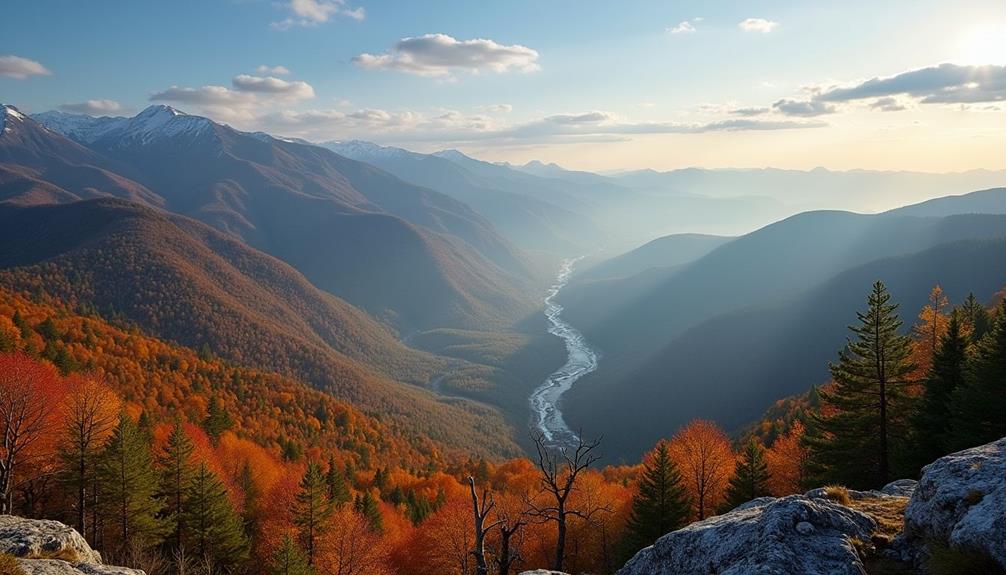Unique Geographical Features

Primorye, located in the southeastern part of Russia, is renowned for its unique geographical features that greatly contribute to its rich biodiversity. The region’s landscape is a mosaic of geological formations ranging from rugged mountains to expansive coastal plains. These formations provide varied habitats that support a wide array of flora and fauna.
The Sikhote-Alin mountain range, a UNESCO World Heritage site, stands as a hallmark to the region’s dramatic topography, creating microclimates and niche environments that foster biodiversity.
Climatic influences also play a pivotal role in shaping Primorye’s natural wealth. The area experiences a monsoonal climate, with cold, dry winters and warm, humid summers. This climatic duality allows for a diverse range of ecosystems to flourish, from temperate rainforests to boreal woodlands.
The climatic variations between the coastal and inland areas further diversify the habitats, making Primorye a haven for species that thrive in different environmental conditions.
The intersection of these geological and climatic factors underpins Primorye’s status as a biodiversity hotspot. For those who seek freedom in nature’s embrace, Primorye offers an unparalleled blend of natural beauty and ecological richness.
Diverse Ecosystems
A diverse array of ecosystems characterizes the Primorye region, each contributing uniquely to its overall biodiversity. From dense temperate forests to coastal wetlands and alpine meadows, Primorye’s varied landscapes support an impressive range of flora and fauna. The region’s unique geographical features foster habitat connectivity, enabling the free movement of species across different ecosystems, which is crucial for maintaining genetic diversity and ecological balance.
Primorye’s forests, dominated by Korean pine and mixed broadleaf species, provide invaluable ecosystem services such as carbon sequestration, water filtration, and soil stabilization. These forests also serve as critical habitats for numerous species, offering shelter and sustenance.
The region’s wetlands, including river deltas and coastal marshes, play a significant role in flood mitigation and water purification, while also hosting myriad bird species during migration periods.
Alpine meadows, found in Primorye’s higher elevations, are rich in endemic plant species and offer grazing grounds for various herbivores. These meadows, along with other ecosystems, form an intricate web of life that underscores the importance of preserving habitat connectivity.
Iconic Wildlife Species

The remarkable biodiversity of Primorye’s diverse ecosystems is additionally exemplified by its iconic wildlife species. Among these, the Amur tiger stands out as a symbol of strength and resilience. As one of the largest cats in the world, this apex predator plays a vital role in maintaining the balance of its habitat, influencing wildlife interactions and ensuring ecological stability.
The region also harbors the elusive Amur leopard, another magnificent predator that, despite its critically endangered status, continues to roam the dense forests of Primorye.
Endemic species like the Blakiston’s fish owl, one of the largest owls globally, add to the unique wildlife tapestry of the area. This nocturnal hunter, with its impressive wingspan, relies on pristine river ecosystems, illustrating the interconnectedness of species and their habitats.
Additionally, Primorye’s coastal areas are frequented by the endangered western gray whale, whose migratory patterns underscore the region’s importance as a biodiversity hotspot.
These iconic wildlife species not only contribute to the ecological richness of Primorye but also inspire a sense of wonder and a desire for conservation. Their presence is a reflection of the wild, untamed beauty that awaits those who seek freedom in nature’s embrace.
Rare Plant Varieties
Boasting an array of rare plant varieties, Primorye’s botanical diversity rivals its rich fauna. This region, nestled in Russia’s Far East, is a haven for endemic species that can be found nowhere else on Earth.
From the delicate Primula sachalinensis to the towering Korean Pine (Pinus koraiensis), the flora of Primorye showcases an extraordinary spectrum of life that underscores the ecological richness of the area.
Botanical gardens in Primorye serve as essential sanctuaries for these rare plants. These gardens not only provide a space for scientific research and conservation but also offer the public an opportunity to appreciate and understand the importance of preserving these unique species.
It is in these curated environments that visitors can marvel at the rare and endemic varieties, such as the Ussuri pear (Pyrus ussuriensis) and the vibrant Rhododendron fauriei.
Conservation Efforts

Conservation initiatives in Primorye are essential for safeguarding its unparalleled biodiversity. The region’s unique ecosystems, home to endangered species such as the Amur tiger and the Far Eastern leopard, require meticulous habitat preservation. Efforts spearheaded by local and international organizations focus on creating protected areas, restoring natural habitats, and enforcing anti-poaching laws. These measures guarantee that wildlife populations can thrive in their natural surroundings without human interference.
Sustainable practices are at the heart of these conservation efforts. By promoting environmentally-friendly agricultural methods and responsible forestry, local communities can coexist with nature rather than deplete its resources. Programs encouraging the use of renewable energy sources and reducing pollution further contribute to maintaining the ecological balance.
Public awareness and education are also critical components of conservation in Primorye. By fostering a culture of respect and appreciation for the natural world, initiatives aim to empower individuals to take actionable steps towards environmental stewardship.
Collaborative efforts between government agencies, non-profits, and local residents create a thorough approach to conservation, guaranteeing that Primorye’s rich biodiversity is preserved for future generations. Through these concerted efforts, the region continues to be a sanctuary for some of the world’s most remarkable species.
Ecotourism Opportunities
Beyond conservation, Primorye’s rich biodiversity also presents abundant ecotourism opportunities, offering unique experiences for nature enthusiasts and adventure seekers alike.
Nestled in the far eastern reaches of Russia, Primorye boasts a plethora of natural wonders, from the pristine coastline of the Sea of Japan to the dense, unspoiled taiga forest. Ecotourism in this region is not merely about observing nature but actively engaging with it through sustainable travel practices that minimize environmental impact.
Visitors can commence on guided treks through the Sikhote-Alin Mountains, home to the elusive Amur tiger and the endangered Far Eastern leopard. Birdwatchers may find a paradise in the wetlands of Khanka Lake, where rare migratory birds flock in abundance. These activities provide an avenue for tourists to appreciate the region’s biodiversity while contributing to the preservation of these habitats.
Moreover, ecotourism in Primorye serves as a vital economic driver for local communities. By promoting sustainable travel, ecotourism initiatives create jobs and foster appreciation for the natural environment among residents and visitors alike.
This symbiotic relationship guarantees that the region’s natural beauty remains intact for future generations to explore and cherish.




